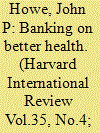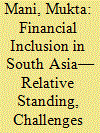| Srl | Item |
| 1 |
ID:
132541


|
|
|
|
|
| Publication |
2014.
|
| Summary/Abstract |
HIV is no longer a death sentence" - that hopeful declaration-which would have been unthinkable even a decade ago- has now become a cliché by repetition whenever experts, physicians, academics and journalists gather to chart progress in fighting the disease and to set goals for the future. But for many people, sadly, that statement is not actually true. There remains no cure for the disease, and not everyone can get access to the anti-retrovirals (ARVs) that have done so much to help so many. This reflects the painful truth that poverty remains a major impediment to good health in the developing and even the developed world.
|
|
|
|
|
|
|
|
|
|
|
|
|
|
|
|
| 2 |
ID:
148843


|
|
|
|
|
| Summary/Abstract |
On January 23rd this writer was invited to speak at the All India Bank
Employees Association (AIBEA) annual meeting, led by the Punjab
National Bank, on The Future of Democracy in India. The theme seemed
a little incongruous for an occasion where, “Comrades of the World
Unite,” to discuss their welfare. In fact, I wonder if bankers ever have
the time to think or worry about democracy. Judging by the mechanical
manner in which the customers who enter the banks are greeted it
would seem that democracy is an outlandish concept.
|
|
|
|
|
|
|
|
|
|
|
|
|
|
|
|
| 3 |
ID:
161099


|
|
|
|
|
| Summary/Abstract |
Financial Inclusion is eminent for sustained growth in South Asia. This study is
an attempt to measure and comparatively analyze the levels of financial inclusion
in South Asian countries. On the basis of eighty-nine parameters, it is found that
the situation of financial inclusion in South Asia is modest as compared to other
regions of the world. The usage of banking services, use of debit and credit cards,
bank-borrowing, deposit of savings is at low levels. The use of e-banking is also
extremely low; however, the mobile-banking is picking up. The gender bias is high
in most of the countries as there are more male users as compared to female
users. Many initiatives are being taken to promote financial inclusion and the
situation has also improved data-wise, but there is still is a long way to go. This study
is distinguished in providing a comparative picture of South Asian countries.
|
|
|
|
|
|
|
|
|
|
|
|
|
|
|
|